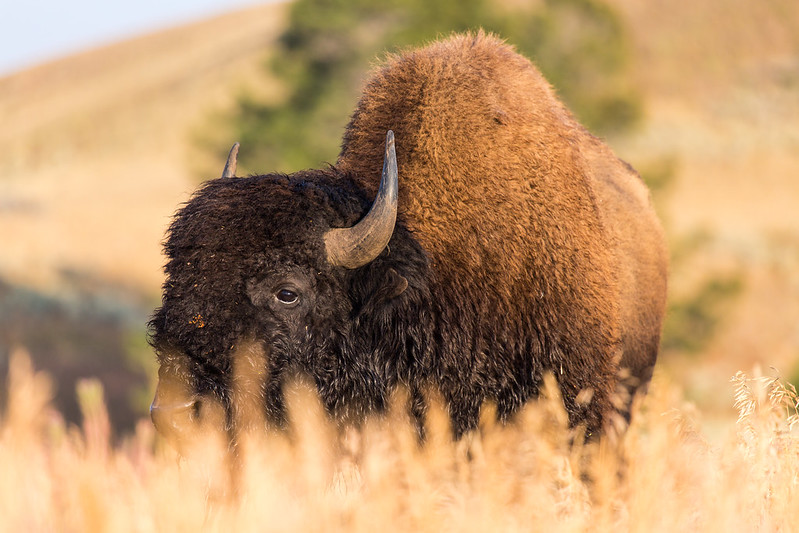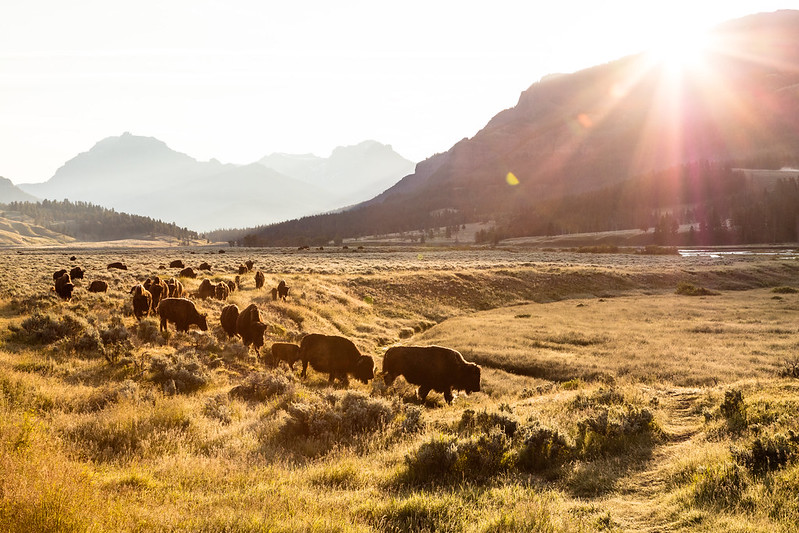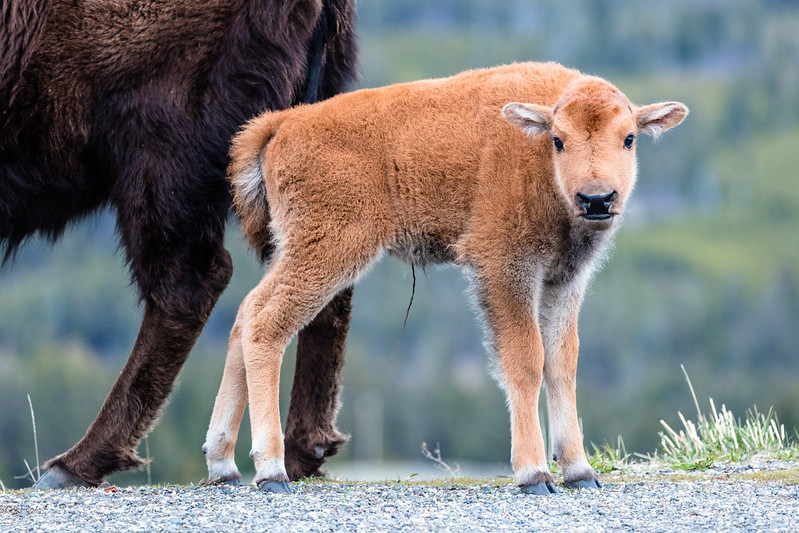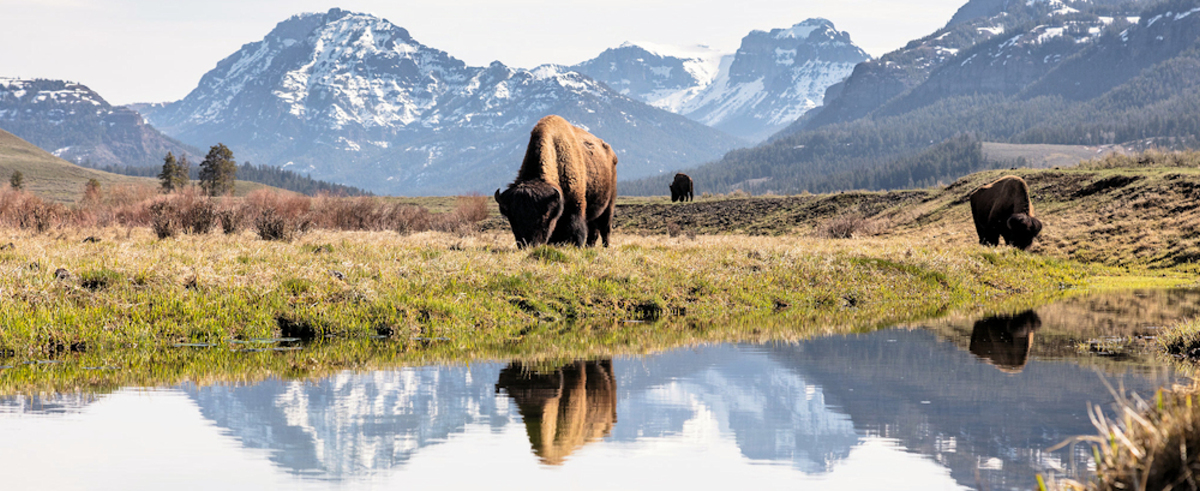Frequently Asked Questions about Bison Natural History
Q: How many bison live in Yellowstone National Park?
A: The bison population fluctuates from 2300 to 4500 animals.
Q: How many bison herds live in Yellowstone National Park?
A: Scientists explain that two subpopulations, defined by their gathering for breeding, occur here: Northern Range (also known as the northern herd) and Hayden Valley (also known as the central herd).

Q: Are bison an endangered species?
A: Bison (scientific name: Bison bison) are not listed as a threatened or endangered species. Approximately 30,000 bison live in public and private herds in North America; they are managed for conservation goals. Approximately 400,000 bison are raised as livestock.
Q: Why do so many people consider the bison in Yellowstone National Park to be special?
A: Yellowstone is the only place in the United States where bison have lived continuously since prehistoric times. A number of Native American tribes especially revere Yellowstone’s bison as pure descendants of the vast herds that once roamed the grasslands of the United States. The largest bison population in the country on public land resides in Yellowstone. It is one of the few herds free of cattle genes.
Q: How big is a bison?
A: The bison is the largest land mammal in North America. Males (bulls) weigh up to 2,000 pounds, females (cows) weigh up to 1,000 pounds.
Q: How fast can a bison run?
A: A bison is agile and quick, and can run more than 30 miles per hour. A bison can also pivot quickly—an advantage when fighting predators that aim for hindquarters.
Q: How do you tell male from female bison?
A: A bull’s head is wider and shaped more like a triangle than the female bison; its “forehead” fur is much thicker, as is the fur on its forelegs; and its beard is thicker. A cow’s horns are slightly more curved and slender than a bull’s. In addition, a cow’s shoulders are narrower than its hips while a male’s shoulders are broader than its hips.
Q: How do bison stay warm in winter?
A: Bison have excellent winter insulation: thick skin and underfur, long guard hairs, and layers of fat.
Q: Bison seem to be very bony in the spring; how many die during the winter?
A: On average, 9 out of 100 adult bison will die during the winter. Generally these animals entered winter in poor condition due to age, disease, or injuries. Young bison entering their first winter face a higher risk of dying: 20 to 40 of every 100 first-year animals may die from accidents, winter exposure, or predation.
Q: Why do bison roll in the dirt?
A: This rolling, also called wallowing, deters biting flies and removes tufts of molted fur. Bison also leave their scent in the wallow. And during the rut, bull bison wallow to display their strength and vigor.
Q: What do they eat?
A: Bison eat primarily grasses and sedges.

Q: Why do they have a big hump?
A: A bison’s massive hump is comprised of muscles supported by long vertebrae; this allows a bison to use its head as a snowplow in winter, swinging side to side to sweep aside the snow.
Q: Do bison ever live alone?
A: Mature bulls spend most of the year alone or with other bulls—except during the rut, or mating season.
Q: When is the rut?
A: The rut begins in late July and goes through August. Bulls display their dominance by bellowing, wallowing, and fighting other bulls. Once a bull has found a female who is close to estrus, he will stay by her side until she is ready to mate. Then he moves on to another female.
Q: When does a bison first breed?
A: Bison are sexually mature at age 2. Many female bison breed at this age, but usually not males. The older males (>7 years) participate in most of the breeding.
Q: When are calves born?
A: Reddish-brown calves are born in late April and May, after a gestation period of 9 to 9½ months. Calves can keep up with the herd 2 to 3 hours after birth and they are well protected by their mothers and other members of the herd. However, wolves and grizzly bears can kill bison calves.
Q: What predators kill adult bison?
A: Wolves and grizzly bears can kill adult bison.
Q: Do bison migrate?
A: Yes, bison are migratory animals. When and where they migrate depends on a complex relationship between abundance of bison, quality and quantity of summer forage, and winter snowpack. In the Yellowstone area, they move from their summer ranges to lower winter ranges as snow accumulates and dense snowpack develops. The central herd moves both west and north toward park boundaries in winter, and may remain along the west boundary well into birthing season. The northern herd migrates within the park most winters, but will move beyond the north boundary in severe winters.
Q: Have bison always lived in Yellowstone?
A: Yellowstone is the only place in the United States where bison have lived continuously since prehistoric times. We know they lived here in centuries past due to fossils and the stories of the earliest travelers to this region.
Q: How many bison used to live in what is now the United States?
A: From 30 to 60 million bison may have roamed North America before the mid-1800s. They ranged across the continent, but the majority lived on the Great Plains.

Q: Were bison hunted almost to extinction?
A: After tribes acquired horses in the 1600s, they could travel farther to find bison and hunt the animals more easily. However, they generally did not hunt to excess. Market hunting and sport hunting in the 1800s by European-American settlers killed far more bison than tribes ever did.
In addition, the U.S. Army held a campaign in the late 1800s to eliminate bison as a way to control tribes that depended on bison. Yellowstone was the only place in the contiguous 48 states where wild, free-ranging bison persisted into the 20th century. Ironically, the U.S. Army, which administered Yellowstone at that time, protected these few dozen bison from poaching as best they could.
The Lacey Act was passed in 1894 to allow stronger punishment for poachers. Even so, Yellowstone’s bison were reduced by poaching to approximately two dozen animals in 1902. From that small herd has grown the two large herds now occupying Yellowstone National Park.
Many people consider the protection and recovery of bison in Yellowstone to be one of the great triumphs of American conservation.
Q: Are all of Yellowstone’s bison descended from these few animals?
A: No. Fearing the demise of the wild herd, the U.S. Army brought 21 bison from two private herds to Yellowstone in 1902. These animals were protected and managed in Mammoth at first, and then at the Buffalo Ranch in the Lamar Valley. Meanwhile, the original herd slowly increased. In several different stages during the first half of the 20th century, the captive bison began to mix with the wild bison. The ranching operation was phased out by 1952.
